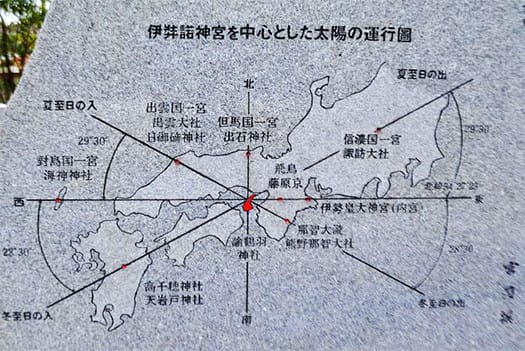



年末年始の時期には雪で閉ざされる北海道を離れ、本州以南地域を旅することが習慣化。その旅先も四国などが中心になって最寄りの利便のいい空港は神戸空港。そこから気ままな旅程を組めるレンタカーでの移動が通常ルートになった。そうすると淡路島・瀬戸内海地域行脚が定番化する。
淡路島が移動交通の要衝に。札幌函館間往復600kmが一般的移動範囲である北海道人としては、淡路島というのはそれこそ指呼の距離感覚。旅するうちに、淡路には国生みにまつわる伝承や神社などの存在が多いことに気付かされ。こうした流れでおのころ神社参詣から今回は深掘り型に。
どうも天沼矛(あめのぬほこ)神話について中央構造線の存在と、鳴門のうずしおのことが強く想像力を刺激される。〜イザナギの命、イザナミの命の二神は神聖な沼矛(ぬぼこ)で国造り。天の浮橋に立ち授かった矛で混沌とした世界をかき回した。潮をゴロゴロと鳴らし引き上げた矛の先から落ちた雫が固まって島となった。〜このかき回し伝承と鳴門のうずしお、そしておのころ島の擬定地・沼島の上立神岩などの符合に、古代の列島自然地形観察の痕跡を見るように思える。
そしてさらに淡路の伊弉諾神宮で見ていた「太陽の運行図」が思い起こされる。この神宮の真東には飛鳥藤原京や伊勢神宮などが位置しているという宮司さん作成になる説明石版図。この図を見ていたときにはこじつけ的な説ではないかと疑念を抱いていたのですが、考えて見ると、古代の稲作農業の支配者たる王権にとって、季節運行の民衆への明晰な説得力のある指示が不可欠だった。いつタネを植え、田にはいつ苗を植えるべきか、それに合理的判断と指示が決定的に重要だと考えられる。太陽の季節運行は「科学根拠」そのものだっただろう。
国生み神話にあってなぜ淡路が特別な地位を受けていたのか。やはりヤマト王権にとって非常に重要な出自地域だったことを表している可能性が高いと思う。真東に初期王権地の飛鳥があり、そこをめざして「東征」した神武の行動指針が腑に落ちるように思われる。古代は神話であると同時に合理的な行動根拠を持っていたと思われる。神武は橿原に宮を建てたとされるけれど、その子孫・崇神は祭政分離を目指して、伊勢を祭事の中心と定めていくようになる。
このような王権としての行動意思決定に、太陽の道行きが深く考慮されたことは自然だろう。ただ、たくさんの先人の列島自然観察という経験知はあったにせよ、太陽の道の詳細な特定方法はどういうものであったのか、現代人としては大きな疑問に突き当たらざるを得ない。
English version⬇
Naruto Uzushio, Izanagi Shrine, and the Path of the Sun: Exploration of Naruto Uzushio and Izanagi Shrine - 3
Asuka, Fujiwara-kyo and Ise Jingu are located directly east of Izanagi Shrine. The Yamato kingdom "conquered" the east to that place. Is there any scientific basis for the ancient principle of action? ......
During the year-end and New Year's holidays, it has become a habit to leave snowy Hokkaido and travel to the south of Honshu. The destinations of these trips are now mainly in Shikoku and the nearest convenient airport is Kobe Airport. The nearest convenient airport is Kobe Airport, from which the usual route is to rent a car for a flexible itinerary. In this way, travel to Awaji Island and the Seto Inland Sea region became the standard route.
Awaji Island has become a key location for transportation. For Hokkaido residents, whose typical round-trip distance between Sapporo and Hakodate is 600 km, Awaji Island is just a stone's throw away. As I traveled, I became aware that there are many shrines and folklore related to the birth of the nation on Awaji. In this vein, I started with a pilgrimage to Onokoro Shrine, and this time, I delved deeper.
The existence of the Median Tectonic Line and the Uzushio of Naruto strongly stimulated my imagination about the myth of Amanuma no Mako (Amanuma no Nuhoko). 〜The two deities, Izanagi and Izanami, used the sacred Nuboko to create the nation. Standing on the floating bridge of heaven, they stirred up the chaotic world with the spear they were given. The drops that fell from the tip of the spear, which rumbled with the tide, hardened and became an island. 〜The coincidence of this stirring legend, the Uzushio of Naruto, and the pseudo-figures of Onokoro Island and the Kamitatekami rocks of Numajima, seem to show traces of ancient observation of the natural topography of the archipelago.
Furthermore, I am reminded of the "sun's motion chart" that I saw at Izanagi Shrine in Awaji. The map was a lithograph made by a shrine priest explaining that the Asuka Fujiwara-kyo Palace and the Ise Jingu Shrine were located directly east of this shrine. When I saw this diagram, I had my doubts that it was a concocted theory, but when I thought about it, clear and convincing instructions to the people on seasonal operations were essential for the royal authority, the ruler of rice agriculture in ancient times. When seeds should be planted and when seedlings should be planted in the rice fields, rational judgment and direction were considered critically important. The seasonal operation of the sun would have been the "scientific basis" itself.
Why did Awaji receive a special status in the myth of the birth of the nation? I think it is highly likely that it represents an extremely important region of origin for the Yamato kingdom. Asuka, the site of the early Yamato kingdom, was located directly east of Awaji, and it seems to make sense that Jinmu's course of action was to "conquer" the east in order to reach Asuka. In ancient times, it is thought that he had a rational basis for his actions as well as a mythological one. Although Jinmu is said to have built a palace in Kashihara, his descendant, Choshin, aimed for a separation of rituals and government, and came to designate Ise as the center of rituals.
It is natural that the path of the sun was deeply considered in the decision-making process as a royal authority. However, even though many of our ancestors had empirical knowledge from their observation of nature in the archipelago, we must face a big question as modern people: What was the detailed method of identifying the path of the sun?



















